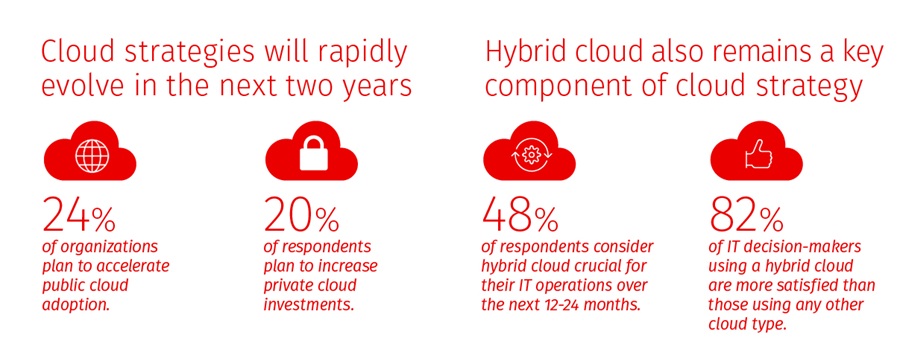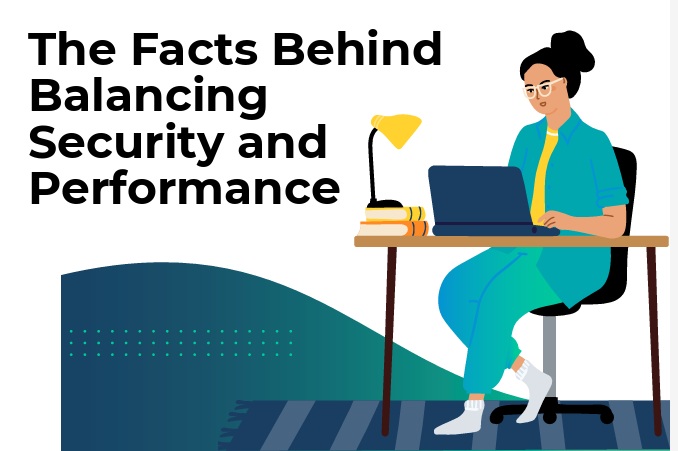Organizations continue to shift away from a single cloud approach toward more flexible hybrid cloud environments, according to the 2025 State of Cloud Report, conducted by Rackspace Technology.
The survey found that over 90% plan to make significant changes in their cloud strategy over the next two years. Of those respondents, 48% said that a hybrid cloud for multi-environment deployment will be critical to their IT operations over the next 12-24 months.

Source: Rackspace
In addition, the results revealed 22% will accelerate hybrid cloud adoption, and 20% plan to invest in private cloud. Respondents indicated that these shifts are driven by a desire to prioritize flexibility, adaptability, and resilience amid demands for AI integrations that can improve operational efficiency and data analysis capabilities.
Despite the steady adoption of public clouds, IT teams are not preparing to abandon private clouds. Over two-thirds (69%) of respondents stated that their organizations had considered repatriating at least a portion of their workloads from public clouds back to private clouds or on-premises infrastructure, citing data security and compliance requirements (50%), better integration with existing systems (48%), and cost savings (44%) as rationales. For those that had recently repatriated workloads, nearly 80% of respondents reported that it had resolved those concerns.
Although the importance of cloud deployments is widely recognized, the survey reveals a significant gap in its full adoption among enterprises. Only 16% of respondents reported that cloud adoption is fully integrated into their business strategy and aligned with their business objectives with advanced practice areas in place. This group, identified in the report as Cloud Leaders, reported that their cloud environments exceeded expectations at 62% compared to only 37% of all survey respondents.
In addition, survey responses revealed that the Cloud Leaders are:
■ more likely to use a particular cloud platform because it is well aligned with their overarching cloud strategy.
■ leading when it comes to the integration of AI initiatives, with 37% using AI-driven cloud optimization to refine their cloud strategy, compared to 25% of others.
■ likely to leverage comprehensive workload-by-workload analysis to decide where to host all their workloads.
"As AI continues to drive rapid advancements, IT leaders are reevaluating their approach to workload management. Instead of updating existing infrastructure, they are designing entirely new cloud strategies to meet evolving demands," said Srini Koushik, President AI, Technology and Sustainability at Rackspace Technology. "To future-proof their organizations, many are transitioning from a 'one-size-fits-all' model in favor of a more flexible and resilient multi-strategy approach. This pivotal moment for hybrid and multi-cloud solutions empowers organizations to choose services tailored to their unique technical requirements and workloads."
A driving force behind the desire for multi-solution approaches is the ease with which organizations can move data between different cloud environments, with 86% stating that they can transfer workloads seamlessly between the public and private cloud and 83% reporting that they can do so between multiple public cloud hyperscalers.
AI Is the Catalyst for Next-Gen Cloud Developments
Development of AI initiatives remains a key focus for IT teams, with 84% of respondents reporting that they have taken steps to integrate their AI and cloud strategies. When asked about the business outcomes that were driving the integration of AI and cloud, 49% reported that their goal is to enhance operational efficiency, while 45% are leveraging AI to improve the insights generated by data analytics.
Major Hurdles Remain to Full Implementation of Cloud and AI Strategies
Although IT leaders are bullish on the prospect of cloud and AI integrations, talent and resource shortages remain major pitfalls that could limit their ability to fulfill these goals. 40% of respondents cited a lack of skilled cloud professionals as being a constraint, while 37% said that insufficient budgets are limiting their ability to meet business demands.
This trend is consistent with insights from Forrester's 2024 State of Cloud in the US Report. Their research found that US enterprise cloud decision-makers saw AI/ML as the most critical cloud technology area, with 24% looking to hire new staff skilled in these areas and an additional 25% planning to retrain existing staff to meet these needs.
"As organizations continue to advance their cloud infrastructure and leverage more complex environments such as hybrid and multi-cloud, the demand for skilled professionals is outstripping the supply," said Ben Blanquera, VP, Technology and Sustainability at Rackspace. "Enterprises must prioritize upskilling their teams to effectively leverage the advanced tools essential for modern IT management … Based on the survey findings, as well as insights from our customers and partners, it's clear that there is strong, continued demand in the market for professionals with expertise in key areas such as Kubernetes, serverless architectures, and cloud security."
Looking Ahead: New Innovations Are Coming, but Security Remains Key Focus
According to the survey, enterprises remain bullish on their efforts to integrate AI and more advanced cloud strategies. Half of respondents listed Cloud Enabled 5G services as one of their top priorities, followed by Cloud Native AI/ML Services (47%), Cloud Based Robotics (40%), and Cloud Based Sustainable Computing (34%).
Data security and compliance remain a key focus with an overwhelming majority (96%) of organizations surveyed having established procedures and policies for data privacy and compliance in cloud environments. 42% of respondents also report that they are leveraging AI for advanced security and threat detection.
Methodology: Commissioned by Rackspace Technology, the survey was conducted by Coleman Parkes Research in October and November 2024. Findings are based on the responses of 1,420 IT decision-makers across manufacturing/logistics, retail, hospitality/travel, energy, healthcare/pharma/biomedical, government, media/entertainment, and financial service sectors in the Americas, Europe, Asia, and the Middle East. Most companies/organizations polled have from 1,000 to 10,000+ employees and annual revenue between $50m and $15b.

